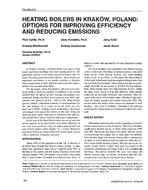Description
In Krakow, Poland, coal-fired boilers are used to heat single apartment buildings and local heating districts. The population includes 2,930 small, hand-fired boilers and 227 larger travelling grate stoker-fired boilers. These boilers are important contributors to air quality problems in Krakow, and on assessment of their efficiency and emissions characteristics was recently undertaken. For the larger, stoker-fired boilers, efficiency was measured using a stack-loss method. In addition to the normal baseline fuel, the effects of coal cleaning and grading were evaluated. Testing was done at two selected sites. Boiler efficiencies were found to be low – 50% to 67%. These boilers operate without combustion controls or instrumentation for flue gas analysis. As a result, excess air levels are very high – up to 40% – leading to poor performance. Emissions were found to be typical for boilers of this type. Using the improved fuels yields reductions in emissions and improvement in efficiency when combined with proper adjustments. In the case of the hand-fired boilers, one set of cast-iron boilers and one set of steel boilers were tested. Efficiency in this case was measured using an input-output method for sets of three boilers taken together as a system. Emissions from these boilers are lowest when low volatile fuels, such as coke or smokeless briquettes, are used.
KEYWORDS: year 1995, heating, boilers, Poland, efficiency, air pollution, flats, district heating, outdoor, measuring, flue gases, heat loss, testing, performance, coal fired boilers, particles, carbon monoxide, organic compounds, nitrogen oxides, sulphur dioxide, comparing
Citation: Symposium, ASHRAE Trans. 1995, Vol.101, Part 1, Paper number CH-95-1-1, 525-527
Product Details
- Published:
- 1995
- File Size:
- 1 file , 1.3 MB
- Product Code(s):
- D-16763




